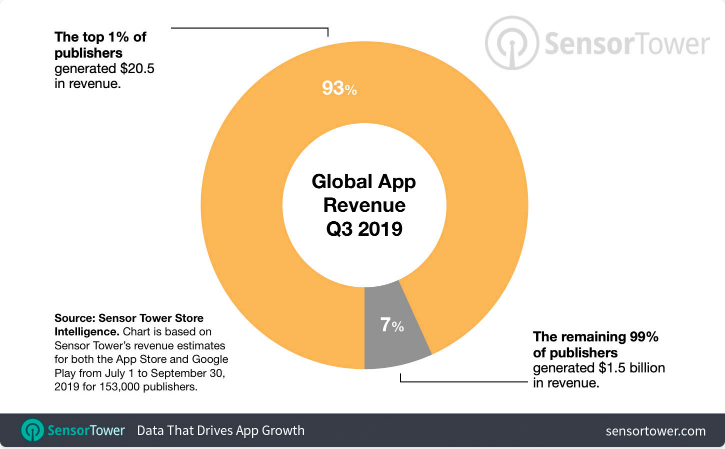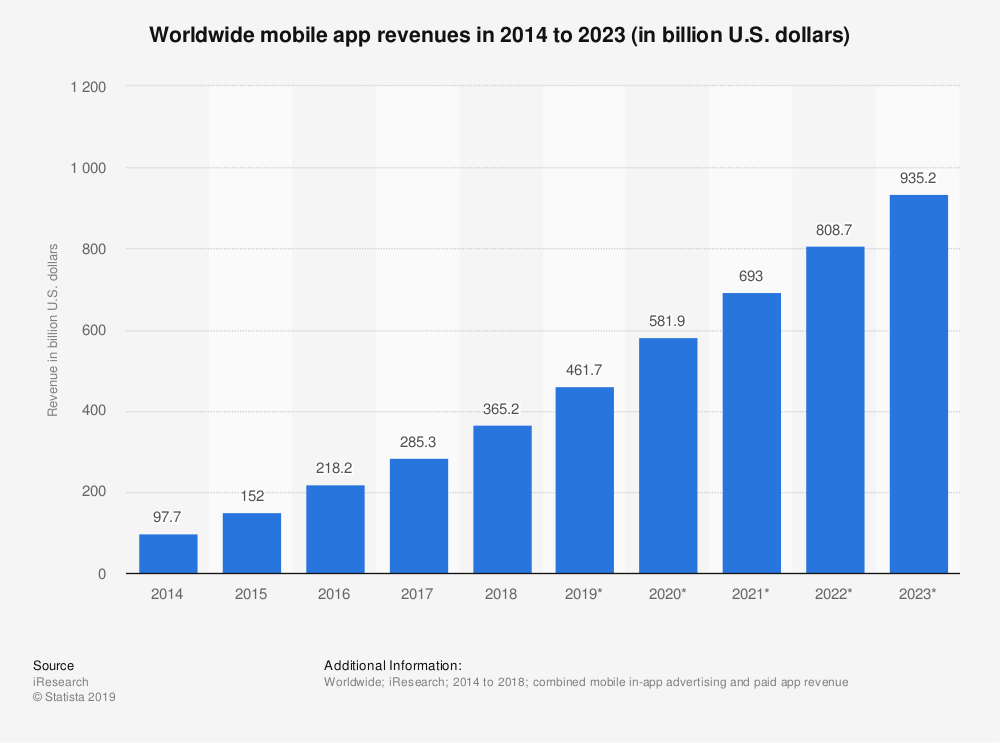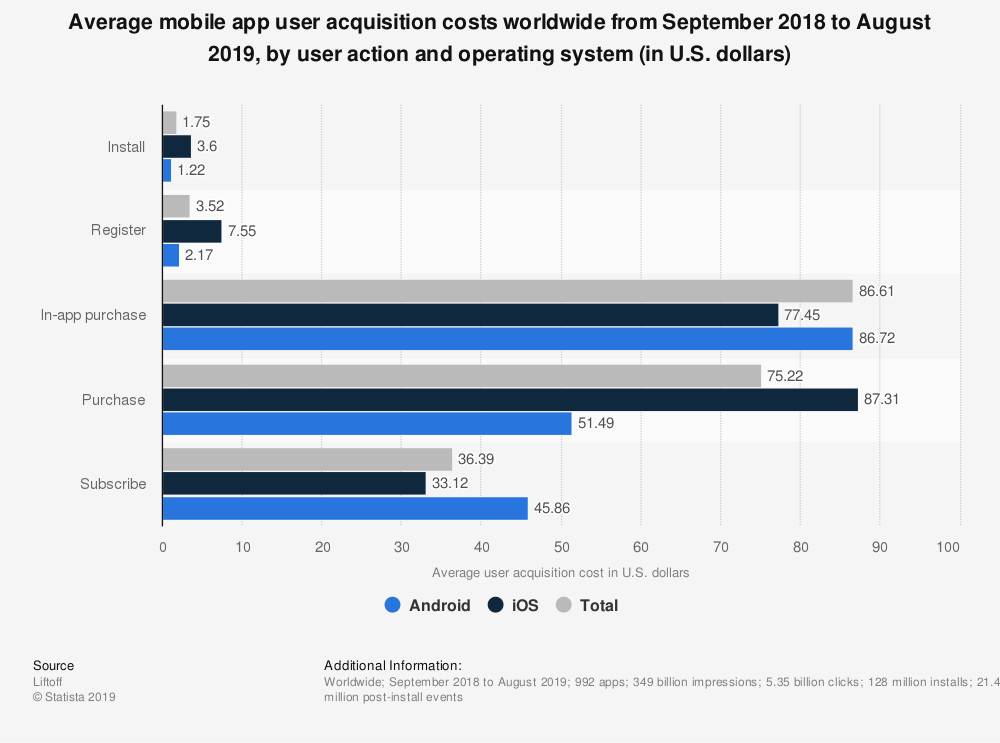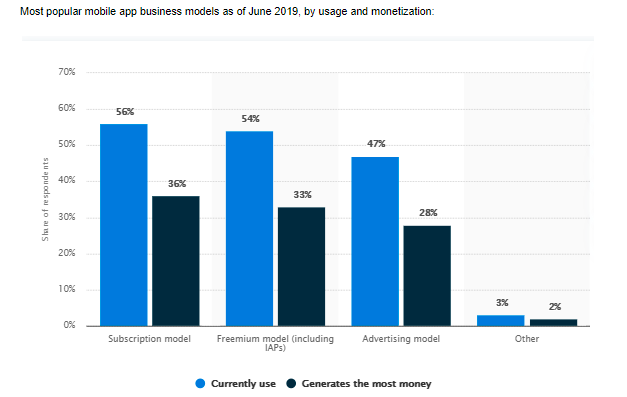You don’t need me to tell you that the app monetization challenge is not an easy one to crack, no matter how experienced you are in the business. As the industry matures, app monetization is only getting more and more complicated.
This pain is well reflected in industry benchmarks: As indicated by SensorTower, over 90% of revenues are generated by only 1% of publishers!!

It’s true that the market keeps growing, but still, millions of apps are fighting to establish their share of the remaining 10%.

There are numerous key reasons for this constant monetization struggle. These include the free business model, the high (and constantly growing) cost of user acquisition, the huge competition bazaar (other apps) that impacts users retention and churn – the list goes on. It’s definitely rough out there.
App companies, therefore, struggle to keep their user acquisition costs significantly lower than their average revenue per paying user (ARPPU). It’s done by optimizing user buying, the product itself, and monetization strategies.
Easier said than done.

Not only are costs always on the rise, the average mobile app loses 57% of its DAUs within the first 30 days after install. Within 60 days, that number jumps to 67%. Within 90 days, it’s over 71%.

Things that I’ve seen…
After working for many years with both top and long-tail app companies and publishers, I’d like to share a few thoughts that I have on key monetization mistakes I keep seeing. This may inspire you to take a different approach and break the vicious cycle of app monetization (or lack thereof).
Mistake # 1 – Opportunistic monetization is a major fault
Having a solid strategy isn’t a cliche. Having a clear strategy means you can present a solid and clear operational planning of which monetization method kicks in and when.
Here are a few questions to help you understand if you have a good enough monetization strategy: Do you have monetization forecasts with regards to user segments (demographics, age, geography, usage, etc.)? And if so, do you have a plan designed to test monetization strategies on different segments and reflect them back to the user acquisition effort? Do you have an automated method designed to optimize your ad monetization fill-rate? How are you planning to develop premium upselling products (for in-app purchases)?
To make a long story short – if I asked you to draw a flow chart of your monetization strategy (one that includes rules, timelines, resources and testing methodology), do you have everything you need in order to do so right now?
You know, a chart like this:

If all you can say is that you currently connect your app to an ad-network (or app mediation platform) and hope for the best, sorry to ruin the party, but that’s not what I mean by having a strategy. Negative ROI is bound to hit.
Tip:
I would make sure to connect my monetization strategy to my user acquisition efforts, and better sooner than later. Reaching a positive ROI is key in keeping your app business resilient, and that can only be done by linking the two.
Also, try to make decisions based on sophisticated analytic tools that can extract actionable insights out of big data. These tools can help you test your monetization strategy by running predictions before it’s enrolled. They can forecast what would happen if you change your user targeting, add specific in-app purchase offerings, or run special promotions based on your past performance or on industry-gained intelligence.
This guide by Appsflyer contains some useful monetization planning techniques that might come handy.
Lastly, as with many other aspects of running a successful initiative, many app companies lean on experienced CROs (Chief Revenue Offices) that they add to their teams. Those experts meticulously plan every possible scenario of user type, usage patterns, and how to optimize monetization based on that. The gaming app industry has long become deft at such planning, and the app industry is catching up fast.
Mistake # 2 – All pros say they act based on data. But do they, really?
We all tend to make emotional and biased decisions. That’s human nature. Well, app publishers are human, and many still don’t fully rely on existing data when making monetization-related decisions.
Using the best technologies for that matter is hard. It’s not only VERY expensive, but it’s also a matter of endless exploration of tools and solutions. That’s why not too many pros know how to run multivariable correlation analyses or other complex calculations in order to users’ LTV.
Do you use conversion funnel analysis, for instance, to understand exactly how people interact with your app? Can you note the clear differences between variables? Not only different user patterns (such as demographics or geos) but also per usage or experience variables. Funnel visualization is just one example of smart data usage. I love this example as it clearly visualizes drop-offs and stages that can be optimized.
Do you know how to identify deep in-app events that signal higher probability for premium purchasing or for higher user loyalty? Such data not only helps optimize user acquisition (and bid for key events rather than installs), but also helps finetune the product towards becoming a revenue machine (again, an aspect that our friends in the mobile gaming industry know something about).
Mistake # 3 – Does your app include enough dynamic content that generates engagement?
Unlike many other fields (such as commerce, B2B services and alike), mobile apps are highly dependent on user engagement, retention, stickiness and attention span to survive and flourish. Whether you monitor ECPMs, ARPDAU, fill rates or other common terms, you know that they all result from your volume of active users and their level of activity.
How do you make users come back and stay for long? What if your app is an alarm-clock? Nutrition support? Fitness? Diet tracker? You get the idea…
I may be colored by my company, but a good way to achieve this is by adding dynamic content layers that are both related to your app and users, and are constantly and automatically being refreshed. Excuse me for using Audioburst talk-audio burst-playlists (Free SDK) as an example.
By adding dynamic content, you expand your app experience and enrich it to optimize both stickiness and session duration.
Many of the app publishers who struggle to make a business out of their product are in fact developing static apps. Such apps serve a specific purpose, and users exit as soon as they get what they want. That makes the mission of making the app addictive, engaging, and widely used, an almost impossible one.
Content changes the picture. Just think of the successful apps that you know and what is the portion of dynamic content in their offering…

Mistake #4 and the last one for today – Multi-source monetization is mandatory for survival
So which monetization tactic is best for your app? Ads? In-app purchases? Subscriptions? Affiliations? Business partnerships? The truth is that in almost all cases, you will need a combination of several models.
A mix of in-app advertising, in-app one-off purchases, subscriptions and special promotions could make a significant difference to the bottom line.
But it’s hard. It takes plenty of resources in terms of development, it demands implementing multiple SDKs, special promotions that are heavy-lifting in terms of marketing, and it makes the whole strategy (scroll up to remember) even more complex.
Well, a key mistake is to lean on a single model. Another related mistake has to do with stagnation in every existing model. Let’s take ad publishing as an example. If you are leaning entirely on ad publishing, you should not only develop other monetization models, but also increase your inventory by thinking outside the box.
Think about Facebook: First, they had the feed. Then they added a marketplace. Then came groups, videos and endless other content directories that allowed them to increase their inventory and add endless more ad units to be filled.
The talk-audio-bursts playlists that we at Audioburst allow app publishers to add for free (using our SDK), follow this exact idea – adding a whole new layer with a built-in monetization stream that not only interferes with user experience but actually delights them.

Summary
Successful app publishers never stop looking for ways that will help them sleep soundly at night. Every impactful strategy can and should be adjusted along the way. New creative tactics to boost engagement and monetization should be shared between industry veterans and serve to inspire us all. I hope this article was inspiring as I intended it to be.




